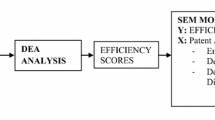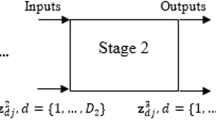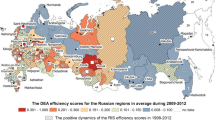Abstract
Universities, research institutes, and firms are the main entities in the national innovation system. Owing to the heterogeneity of their outputs, prior studies have focused on their independent efficiency evaluation. This study adopts the nonhomogeneous data envelopment analysis model to assess the efficiency of three innovation entities in 30 provinces in China on a common platform. Results show that firms have the highest efficiency, and research institutes have the lowest efficiency. Innovation entities perform poorly due to the inefficiency of their subunits. Additionally, the 30 provinces are divided into three clusters by using the hierarchical clustering method. Moreover, Tobit regressions are used to estimate the impact of five environmental factors on the innovation efficiency of the three entities. The regression results show that the more open the region, the stronger the positive impact on the innovation efficiency of research institutes and firms. The regional economic environment has different degrees of negative impact on the three innovation entities. The direction and intensity of the impact of education input, government support, and information infrastructure on the three entities exhibit a large dispersion. The results provide important information for improving the efficiency of innovation entities.




Similar content being viewed by others
Change history
15 April 2024
This article has been retracted. Please see the Retraction Notice for more detail: https://doi.org/10.1007/s10660-024-09844-3
Abbreviations
- DEA:
-
Data envelopment analysis
- IT:
-
Information technology
- MIMO:
-
Multiple input, multiple output
- DMU:
-
Decision-making unit
- R&D:
-
Research and development
- RDP:
-
R&D personnel
- RDE:
-
R&D expenditures
- NPA:
-
Number of patent applications
- CSYS:
-
China Statistical Yearbook on Science and Technology
- SPI:
-
Scientific papers issued
- NPG:
-
Number of Postgraduates
- SRN:
-
Sales revenue of new products
- FTE:
-
Full-time equivalent
- USPTO:
-
United States patent and trademark office
- ESYC:
-
Educational Statistics Yearbook of China
- CPI:
-
Consumer price index
- SPSS:
-
Statistical package for social sciences
- GDP:
-
Gross domestic product
- CSY:
-
China Statistical Yearbook
References
Li, X. (2009). China’s regional innovation capacity in transition: An empirical approach[J]. Research policy, 38(2), 338–357.
Han, U., Asmild, M., & Kunc, M. (2016). Regional R&D efficiency in Korea from static and dynamic perspectives[J]. Regional Studies, 50(7), 1170–1184.
Han, U., Asmild, M., & Kunc, M. (2020). Do research institutes benefit from their network positions in research collaboration networks with industries or/and universities?[J]. Technovation, 94, 102002.
Min, S., Kim, J., & Sawng, Y. W. (2020). The effect of innovation network size and public R&D investment on regional innovation efficiency[J]. Technological Forecasting and Social Change, 155, 119998.
Guan, J., & Chen, K. (2012). Modeling the relative efficiency of national innovation systems[J]. Research Policy, 41(1), 102–115.
Fukuyama, H., Weber, W. L., & Xia, Y. (2016). Time substitution and network effects with an application to nanobiotechnology policy for US universities[J]. Omega, 60, 34–44.
Lee, J., Kim, C., & Choi, G. (2019). Exploring data envelopment analysis for measuring collaborated innovation efficiency of small and medium-sized enterprises in Korea[J]. European Journal of Operational Research, 278(2), 533–545.
Yue, W., Gao, J., & Suo, W. (2020). Efficiency evaluation of S&T resource allocation using an accurate quantification of the time-lag effect and relation effect: A case study of Chinese research institutes[J]. Research Evaluation, 29(1), 77–86.
Shamohammadi, M., & Oh, D. (2019). Measuring the efficiency changes of private universities of Korea: A two-stage network data envelopment analysis[J]. Technological Forecasting and Social Change, 148, 119730.
Ghasemi, N., Najafi, E., Lotfi, F. H., & Sobhani, F. M. (2020). Assessing the performance of organizations with the hierarchical structure using data envelopment analysis: An efficiency analysis of Farhangian University. Measurement, 156, 107609.
Chen, X., Liu, Z., & Zhu, Q. (2018). Performance evaluation of China’s high-tech innovation process: Analysis based on the innovation value chain[J]. Technovation, 74, 42–53.
Anyu, Y., Shi, Y., You, J., & Zhu, J. (2021). Innovation performance evaluation for high-tech companies using a dynamic network data envelopment analysis approach[J]. European Journal of Operational Research, 292(1), 199–212.
Coccia, M., Falavigna, G., & Manello, A. (2015). The impact of hybrid public and market-oriented financing mechanisms on the scientific portfolio and performances of public research labs: A scientometric analysis[J]. Scientometrics, 102(1), 151–168.
Cruz-Cázares, C., Bayona-Sáez, C., & García-Marco, T. (2013). You can’t manage right what you can’t measure well: Technological innovation efficiency[J]. Research policy, 42(6–7), 1239–1250.
Zuo, K., & Guan, J. (2017). Measuring the R&D efficiency of regions by a parallel DEA game model[J]. Scientometrics, 112(1), 175–194.
Zhu, Y., Yang, F., & Yang, M. (2021). Measuring the performance of international trade using a DEA-based approach with trade imbalances consideration. Annals of Operations Research, 1–22.
Zhu, Y., Yang, F., Wei, F., & Wang, D. (2022). Measuring environmental efficiency of the EU based on a DEA approach with fixed cost allocation under different decision goals. Expert Systems with Applications, 118183.
Jiang, R., Yang, Y., Chen, Y., & Liang, L. (2021). Corporate diversification, firm productivity and resource allocation decisions: The data envelopment analysis approach[J]. Journal of the Operational Research Society, 72(5), 1002–1014.
Li, Y., Lei, X., & Morton, A. (2019). Performance evaluation of nonhomogeneous hospitals: The case of Hong Kong hospitals[J]. Health Care Management Science, 22(2), 215–228.
Li, W. H., Liang, L., Cook, W. D., & Zhu, J. (2016). DEA models for non-homogeneous DMUs with different input configurations[J]. European Journal of Operational Research, 254(3), 946–956.
Cook, W. D., Harrison, J., Imanirad, R., Rouse, P., & Zhu, J. (2013). Data envelopment analysis with nonhomogeneous DMUs[J]. Operations Research, 61(3), 666–676.
Cook, W. D., Harrison, J., Rouse, P., & Zhu, J. (2012). Relative efficiency measurement: The problem of a missing output in a subset of decision making units[J]. European Journal of Operational Research, 220(1), 79–84.
Du, J., Chen, Y., & Huo, J. (2015). DEA for non-homogenous parallel networks[J]. Omega, 56, 122–132.
Barat, M., Tohidi, G., Sanei, M., & Razavyan, S. (2019). Data envelopment analysis for decision making unit with nonhomogeneous internal structures: An application to the banking industry[J]. Journal of the Operational Research Society, 70(5), 760–769.
Zhu, W., Yu, Y., & Sun, P. (2018). Data envelopment analysis cross-like efficiency model for non-homogeneous decision-making units: The case of United States companies’ low-carbon investment to attain corporate sustainability[J]. European Journal of Operational Research, 269(1), 99–110.
Jie, W., Li, M., Zhu, Q., Zhou, Z., & Liang, L. (2019). Energy and environmental efficiency measurement of China’s industrial sectors: A DEA model with non-homogeneous inputs and outputs[J]. Energy Economics, 78, 468–480.
Yang, M., Wei, Y., Liang, L., Ding, J., & Wang, X. (2021). Performance evaluation of NBA teams: A non-homogeneous DEA approach[J]. Journal of the Operational Research Society, 72(6), 1403–1414.
Tobin, J. (1958). Estimation of relationships for limited dependent variables[J]. Econometrica: Journal of the Econometric Society, 26, 24–36.
Adam, A., & Tsarsitalidou, S. (2019). Environmental policy efficiency: Measurement and determinants[J]. Economics of Governance, 20(1), 1–22.
Wang, L., Zhou, Z., Yang, Y., & Wu, J. (2020). Green efficiency evaluation and improvement of Chinese ports: A cross-efficiency model. Transportation Research Part D: Transport and Environment, 88, 102590.
Kafouros, M., Wang, C., Piperopoulos, P., & Zhang, M. (2015). Academic collaborations and firm innovation performance in China: The role of region-specific institutions[J]. Research Policy, 44(3), 803–817.
Qin, X., & Du, D. (2018). Measuring universities’ R&D performance in China’s provinces: A multistage efficiency and effectiveness perspective[J]. Technology Analysis & Strategic Management, 30(12), 1392–1408.
Kekezi, O., & Klaesson, J. (2020). Agglomeration and innovation of knowledge intensive business services[J]. Industry and Innovation, 27(5), 538–561.
Amara, N., Rhaiem, M., & Halilem, N. (2020). Assessing the research efficiency of Canadian scholars in the management field: Evidence from the DEA and fsQCA[J]. Journal of Business Research, 115, 296–306.
Liu, C., Gao, X., Ma, W., & Chen, X. (2020). Research on regional differences and influencing factors of green technology innovation efficiency of China’s high-tech industry. Journal of computational and applied mathematics, 369, 112597.
Chen, K., Kou, M., & Fu, X. (2018). Evaluation of multi-period regional R&D efficiency: An application of dynamic DEA to China’s regional R&D systems[J]. Omega, 74, 103–114.
Liu, X., Serger, S. S., Tagscherer, U., & Chang, A. Y. (2017). Beyond catch-up—can a new innovation policy help China overcome the middle income trap? Science and Public Policy, 44(5), 656–669. https://doi.org/10.1093/scipol/scw092
Govender, P., & Sivakumar, V. (2020). Application of k-means and hierarchical clustering techniques for analysis of air pollution: A review (1980–2019)[J]. Atmospheric Pollution Research, 11(1), 40–56.
Wang, S., Fan, J., Zhao, D., & Wang, S. (2016). Regional innovation environment and innovation efficiency: the Chinese case[J]. Technology Analysis & Strategic Management, 28(4), 396–410.
Varis, M., & Littunen, H. (2012). SMEs and their peripheral innovation environment: Reflections from a Finnish case[J]. European Planning Studies, 20(4), 547–582.
Hong, J., Feng, B., Wu, Y., & Wang, L. (2016). Do government grants promote innovation efficiency in China’s high-tech industries? Technovation, 57, 4–13.
Liang, X., & Liu, A. M. M. (2018). The evolution of government sponsored collaboration network and its impact on innovation: A bibliometric analysis in the Chinese solar PV sector[J]. Research Policy, 47(7), 1295–1308.
Cui, T., Ye, H. J., Teo, H. H., & Li, J. (2015). Information technology and open innovation: A strategic alignment perspective. Information & Management, 52(3), 348–358.
Paunov, C., & Rollo, V. (2016). Has the internet fostered inclusive innovation in the developing world?[J]. World Development, 78, 587–609.
Schweikl, S., & Obermaier, R. (2020). Lessons from three decades of IT productivity research: Towards a better understanding of IT-induced productivity effects[J]. Management Review Quarterly, 70(4), 461–507.
Tziogkidis, P., Philippas, D., Leontitsis, A., & Sickles, R. C. (2020). A data envelopment analysis and local partial least squares approach for identifying the optimal innovation policy direction. European Journal of Operational Research, 285(3), 1011–1024. https://doi.org/10.1016/j.ejor.2020.02.023
Potter, A., & Paulraj, A. (2021). Unravelling supplier-laboratory knowledge spillovers: Evidence from Toyota’s central R&D laboratory and subsidiary R&D centers[J]. Research Policy, 50(4), 104200.
Wolszczak-Derlacz, J., & Parteka, A. (2011). Efficiency of European public higher education institutions: A two-stage multicountry approach[J]. Scientometrics, 89(3), 887–917.
Jie, W., Zhang, G., Zhu, Q., & Zhou, Z. (2020). An efficiency analysis of higher education institutions in China from a regional perspective considering the external environmental impact. Scientometrics, 122(1), 57–70. https://doi.org/10.1007/s11192-019-03296-5
Kaihua, C., & Mingting, K. (2014). Staged efficiency and its determinants of regional innovation systems: A two-step analytical procedure[J]. The Annals of Regional Science, 52(2), 627–657.
Acknowledgements
This research was supported by the National Natural Science Foundation of China (71991464, 71921001, and 71671001), and Department of Education of Zhejiang Province (Y202147829).
Author information
Authors and Affiliations
Corresponding author
Ethics declarations
Conflict of interest
The author(s) declared no potential conflicts of interest with respect to the research, author-ship, and/or publication of this article.
Additional information
Publisher's Note
Springer Nature remains neutral with regard to jurisdictional claims in published maps and institutional affiliations.
This article has been retracted. Please see the retraction notice for more detail:https://doi.org/10.1007/s10660-024-09844-3
Appendix
Appendix
See Tables 9,
10,
11,
12.
Rights and permissions
Springer Nature or its licensor (e.g. a society or other partner) holds exclusive rights to this article under a publishing agreement with the author(s) or other rightsholder(s); author self-archiving of the accepted manuscript version of this article is solely governed by the terms of such publishing agreement and applicable law.
About this article
Cite this article
Zhu, Y., Yang, F., Gong, B. et al. RETRACTED ARTICLE: Assessing the efficiency of innovation entities in China: evidence from a nonhomogeneous data envelopment analysis and Tobit. Electron Commer Res 23, 175–205 (2023). https://doi.org/10.1007/s10660-022-09599-9
Accepted:
Published:
Issue Date:
DOI: https://doi.org/10.1007/s10660-022-09599-9




